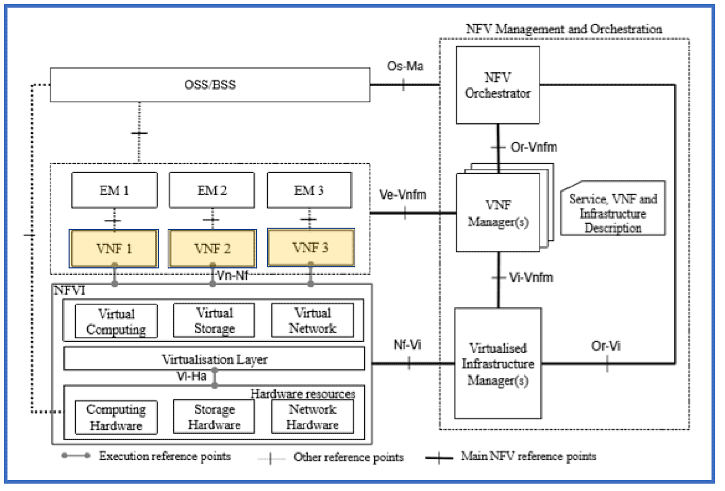What is Network Functions Virtualization & Virtualized Network Functions?
Among network engineers, Network Functions Virtualization (NFV) and Virtualized Network Functions (VNF) are discussed frequently but not without some confusion.
Virtualized Network Functions commonly refers to the software form of network appliances such as a router, firewall, load balancer, etc. VNFs are mostly deployed as virtual machines (VMs) on Linux KVM or VMware vSphere hypervisors on commercial off-the-shelf hardware (COTS). In contrast to Virtualized Network Functions, physical network function (PNF) refers to the legacy network appliances on proprietary hardware. And cloud-native network function (CNF) refers to the containerized Virtualized Network Functions and may be the container networking and service mesh among microservices.
On the other hand, Network Functions Virtualization is a network architecture originally conceived by service providers who wanted to leverage the IT virtualization technology to classes of network nodes in order to make them faster and more agile. The European Telecommunications Standards Institute (ETSI) was the first major organization to release an Network Functions Virtualization standard in Oct 2013 and has subsequently released multiple new specifications on Network Functions Virtualization and its components.
Both European Telecommunications Standards Institute (ETSI) and Linux Foundation (LF) are actively developing and nurturing the reference architecture and standards for the NFV framework. ETSI Open Source MANO (OSM) and Linux Foundation Open Network Automation Platform (ONAP) are the most important open source NFV projects supported by service operators and network vendors.
In ETSI NFV Framework, NFV MANO provides the core operation functionality and is made up by the NFV Orchestrator, VNF Manager, Virtualized Infrastructure Manager (VI Manager), and the interwork among these functional blocks along with other operational systems. In Linux Foundation NFV Framework, ONAP includes all the MANO layer functionality specified by the ETSI NFV Framework, and additionally provides a network service design framework and fault, configuration, accounting, performance and security functionality (FCAPS).
The following ETSI NFV reference architecture provides a great illustration of the relationship between Virtualized Network Functions and Network Functions Virtualization. (Source: ETSI, Network Functions Virtualisation (NFV); Architectural Framework)

Within this ETSI NFV Framework, NFV Orchestrator, VNF Manager(s) and VI Manager(s) deliver the primary NFV MANO functionality. NFV MANO is responsible for
- Interacting with operations and business support systems (OSS/BSS) to deliver business benefits to service providers, such as rapid service innovation, flexible network function deployment, improved resource usage, and reduced CapEx and OpEx costs
- Orchestrating VNFs into network services (NS), deploying and operating the VNF and NS instances on the virtualize resources, and managing the lifecycle of VNF and NS instances to fulfill the business benefits for service providers
- Interacting with element management (EM) to manage the logical function and assure service levels of the VNFs spanning across the management of VNF fault, configuration, accounting, performance and security (FCAPS)
- Interacting with network function virtualization infrastructure (NFVI) to allocate, manage and orchestrate the virtualized resources including compute, storage and network, where VNFs are deployed
At present, the NFV framework is undergoing rapid development because of 5G business opportunities, and its ecosystem is growing with strong support from service operators and all varieties of solution providers. ETSI NFV Release 4 specification work, launched in summer 2019 and will focus on a number of enhancements and features including:
- Network connectivity integration and operational for NFV
- NFV-MANO automation and autonomous networks
- NFV enhancements for 5G
- Multi-tenancy enhancements for NFV-MANO
- Service-based architecture (SBA) for NFV-MANO
- VNF generic management functions, and
- Continuous VNF integration
A10 Networks is an active member in the NFV ecosystem and is committed to the success of NFV in 5G infrastructures. By following the ETSI NFV Framework, A10 Networks delivers its market-proven application availability and security solutions in a consolidated VNF and has validated its end-to-end interoperability with leading NFV MANO and VI solutions in ETSI NFV Plugtests events.
The A10 Thunder VNF features include convergent firewall, site-to-site IPsec VPN, Gi/SGi firewall, roaming firewall and secure web gateway functions for service providers and enterprise customers alike. A10 Networks continues to work with individual NFV MANO partners and 5G service operators on solution demos and proofs-of-concept to further develop 5G-centric use cases and to ensure the success of 5G service delivery.
Related Resources
Read more about the latest developments on:
